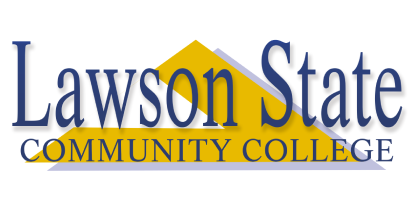
Student Achievement Facts
In accordance with the Southern Association of Colleges and Schools Commission on Colleges, T.A. Lawson State Community College identifies, evaluates, and publishes goals and outcomes for student achievement appropriate to the institution's mission, the nature of the students it serves, and the kinds of programs offered. Lawson State utilizes IPEDS data and SACSCOC Annual Profile data as a metrix to monitor completion of students served by the College.
Student Success and the College's Mission
The College documents successful student achievement in relation to its Mission by monitoring measures such as course completion rates, retention rates, transfer rates, state licensing examinations, and job placement rates and publishes all results. The institution has established internal benchmarks and benchmarks itself against peer institutions (where applicable) to determine overall success and achievement. Comparisons to national averages are also used (where applicable) as well.
Goals AND Benchmarks
The following goals and outcomes to achieve these goals, which were set by the Administrative Leadership Team at Lawson State, exist for student success and achievement and align and support the College's Mission which reads:
With a focus on student success, Lawson State Community College provides affordable and accessible quality educational opportunities, promotes economic growth, and enhances the quality of life for the diverse communities it serves. Through innovated instruction and lifelong learning opportunities, the College prepares students for transfer, gainful employment, and career advancement.
The goals and outcomes that measure Student Achievement at the College are:
- To meet or exceed the IPEDS Graduation / Completion Rate
- To have a Completion / Graduation Rate that is no less than 10% of Peer Institutions
- To increase Completion / Graduation Rate to 15%
- To achieve a 70% successful course completion rate annually
- To have a fall-to-fall retention rate of a minimum of 42%
- To have a transfer rate of a minimum of 55%
- To maintain a licensure rate of a minimum of 80%
- To have a job placement rate annually, no less than 10% below or at the state target level
To assess these identified goals and outcomes, the College uses the following: (1) IPEDS Completion Rates; (2) SACSCOC Peer Group Graduate Rates; (3) Course Completion Rates; (4) Fall-to-Fall Retention Rates; (5) Transfer Rates; (6) NCLEX--Nursing Licensure Examination; and (7) Job Placement Results. If results are not met, the College works through targeted Divisions and Departments to address critical shortfalls.
Student Demographics
Lawson State serves a diverse student population within a diverse community. While 26.8% of its student population is of traditional college age (between 18 and 19), 60.2% of students who attend Lawson State are 20 years of age and older. As such, many Lawson State students can be best categorized as working adults with the high likelihood of having a child or children. Lawson State also has a higher population of female students, 65.2% versus 34.8% male.
Enrollment by Age (Fall 2023)
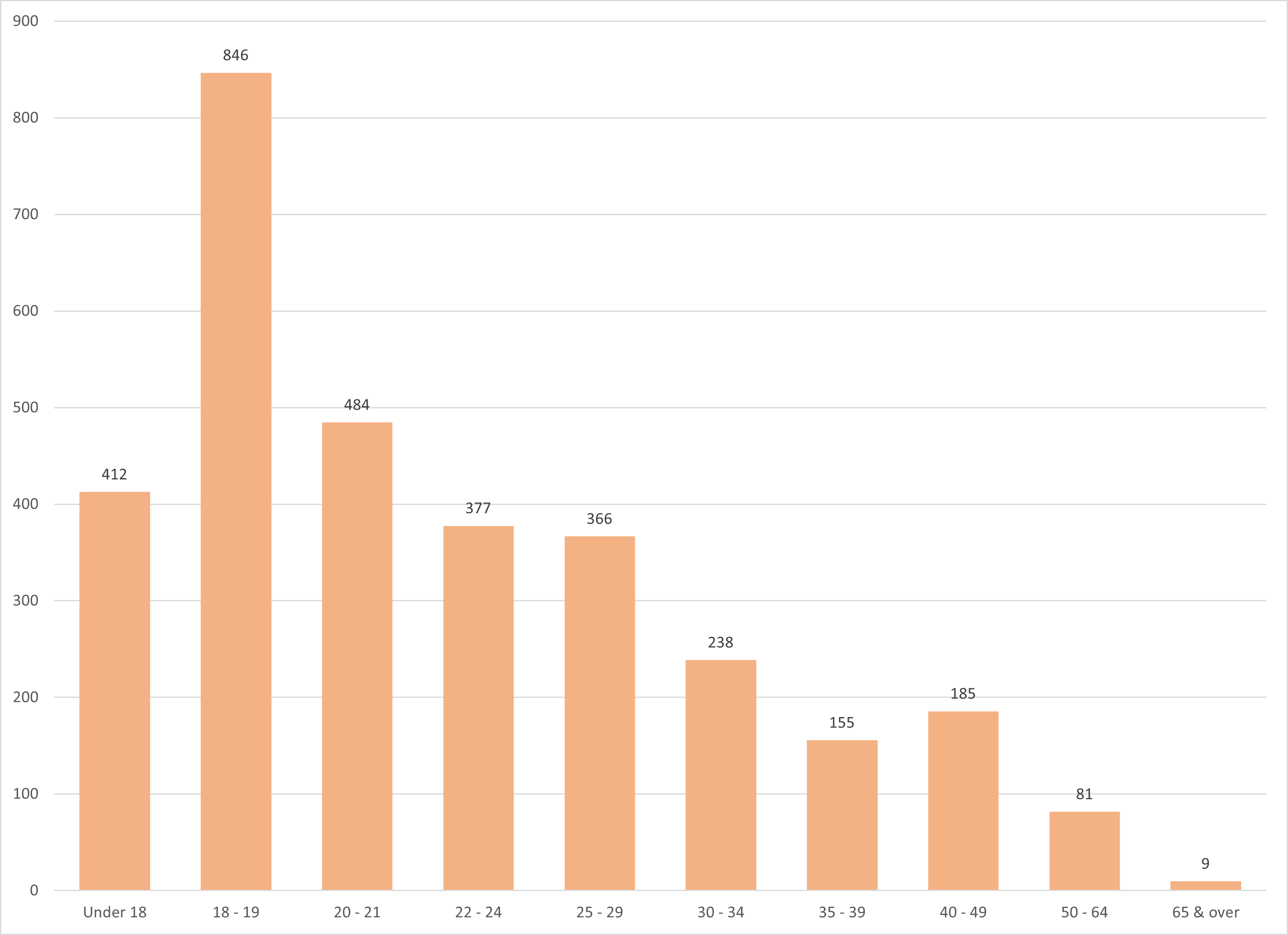
Further, in terms of ethnicity, the College is 81.2% African American, 11.4% White, .6% Hispanic, 5% Multiracial, and 1.8% other. In terms of status, Lawson State also caters to a large part-time student population, where 64.8% of its student population is part-time versus 35.2% full-time.
Given the diversity in the College's student makeup, the rational for attending college varies. Some students attend Lawson seeking General Education degrees to transfer to a four-year college, others are seeking to acquire a specific skill, others come to enroll in a few courses typically associated with work, and others are seeking a specific skill to enhance job skills or to make them eligible for work. For some, it could be to secure their GED or obtain Workforce Skills. As such, the College offers a broad scope of Program Offerings to include General Studies (geared towards Transfer Students), Career Technical options, Business Technologies, Health Professions, and also GED courses and Workforce Development opportunities.
Program Demographics
Program demographics within Lawson's Program Areas of Study are varied and reflect the broad diversity of interest of students at Lawson State. The top 10 largest programs at the College are: Pre-Nursing, General Studies, Business Administration, Psychology, Biology, Pre-Social Work, Pre-Engineering, Liberal Arts, Music, and Art.
Top 10 Enrolled Programs (Fall 2023)
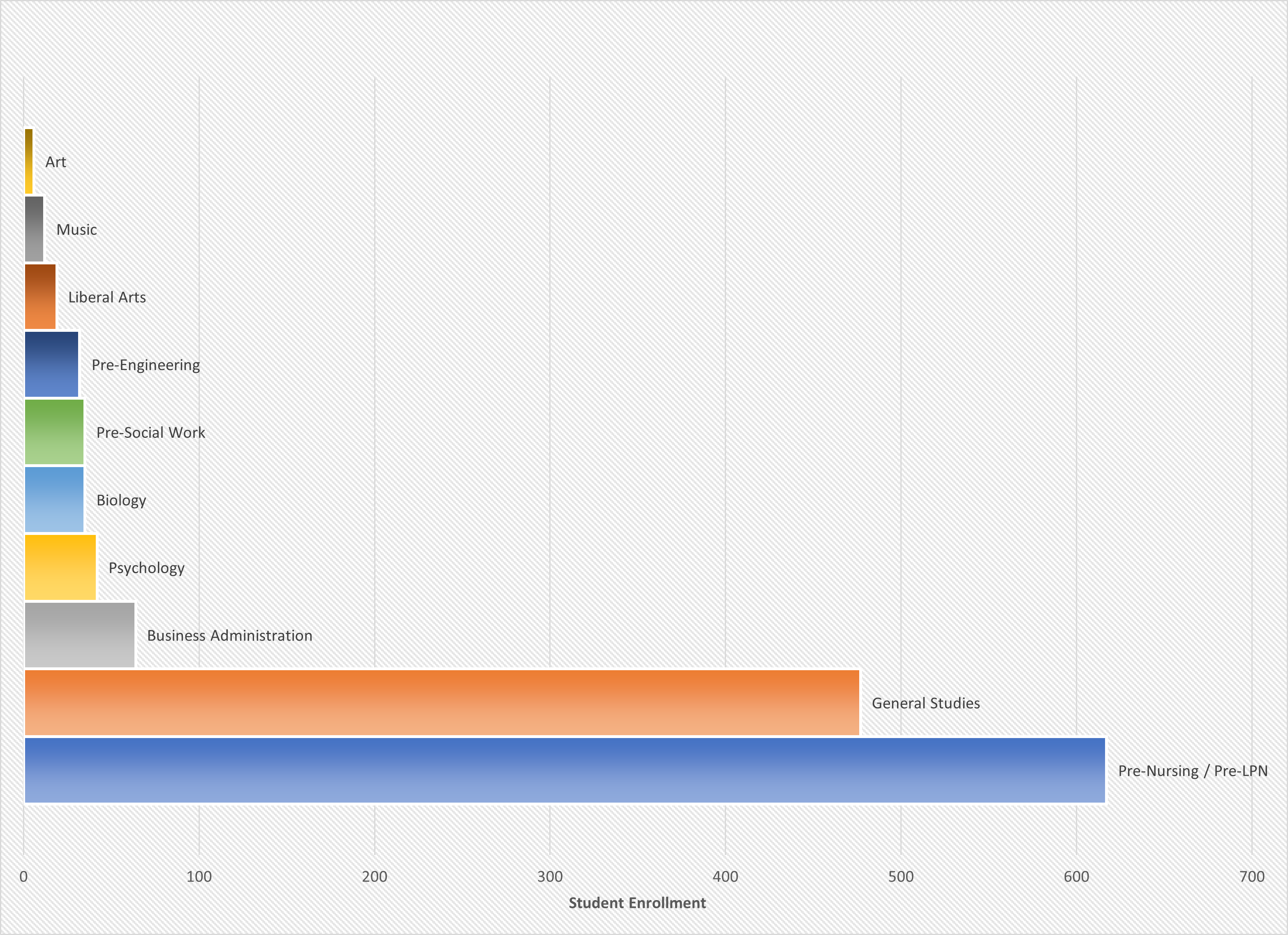
Broad-based Appeal of Programs
The College offers a variety of programs of study to suit its diverse student population. In doing so, not only does the College serve its student population well, but it also prepare students for gainful employment, career advancement, college transfer, and workforce development.
In addition, the College provides flexible scheduling, which makes higher education success more obtainable. Classes for traditional and non-traditional students are available during the day, evening, and online to accommodate individual needs.
Enrollment by Course Type (Fall 2023)

Course Completion Rates and Assessment Results
To make appropriate decisions relative to curriculum and course content, Lawson State Community College evaluates course completion data.
The table below provides this data for academic years 2012 thru 2018. Success is defined by completing a course with a grade of "C" or better, with a grade of "D" or "F" indicating Non-Success. Lawson sets a college-wide internal benchmark of 70% (passing).
Departments use activities and improvements targeted within Student Learning Outcomes to achieve this result.
Course Completion Results
| MEASURE | 2018 - 2019 | 2019 - 2020 | 2020 - 2021 | 2021 - 2022 | 2022 - 2023 |
| SUCCESS | 75.33% | 75.45% | 72.80% | 71.57% | 72.12% |
| NON-SUCCESS | 16.88% | 16.44% | 19.00% | 19.96% | 18.15% |
| WITHDREW | 7.79% | 8.11% | 8.20% | 8.47% | 9.73% |
Other useful tools to evaluate student achievement are fall-to-fall retention rates, 150% graduation rate, and the transfer rate.
Fall-to-Fall Retention Rates
Retention rate is defined as the percentage of a school's first-time, first-year undergraduate students who continue at that school the next year. For example, a student who studies full-time in the fall semester and keeps on studying in the program in the next fall semester is counted in this rate.
In looking at Lawson State's current retention rates of 49.2% (which looks at full and part-time combined students), the College is meeting its pre-set benchmark of 42% retained. This trend of meeting the College's benchmark has been substantiated by analyzing present trend data reports on retention rates at the College.
Further, even though the College continues to meet this benchmark, retention and methods to improve retention maintain itself as a central focus throughout the college. In fact, the College's QEP: Race to the Finish, centers on retention and completion, for it remains a key and vital component to achieving the College's mission overall. In addition, the College utilizes professional development training opportunities to focus on retention efforts college-wide and has had guest speakers on campus to address issues of retention with faculty and staff. Thus, retention tends to be a core focus at the institution.
Retention Data (2019 - 2022)
| YEAR | TOTAL HEADCOUNT | RETURNED OR EARNED AWARD HEADCOUNT | PERCENTAGE |
| 2019 - 2020 | 3,059 | 1,572 | 51.4% |
| 2020 - 2021 | 2,611 | 1,437 | 55.0% |
| 2021 - 2022 | 2,793 | 1,375 | 49.2% |
When looking at data collected by the National Center for Education Statistics, Lawson State has a 62% retention rate of its full-time students and a 38% retention rate of its part-time students (Fall 2020). These results speak to the different aims and goals of the two populations of students, for part-time students may not necessary want to enroll in school until completion of a degree or certificate. Some students engage in college to advance their skill set to make them more marketable in the workforce, or may be coming to school to take a few courses and then transfer; it varies.
Full-time vs. Part-time Retention Data (Fall 2020)
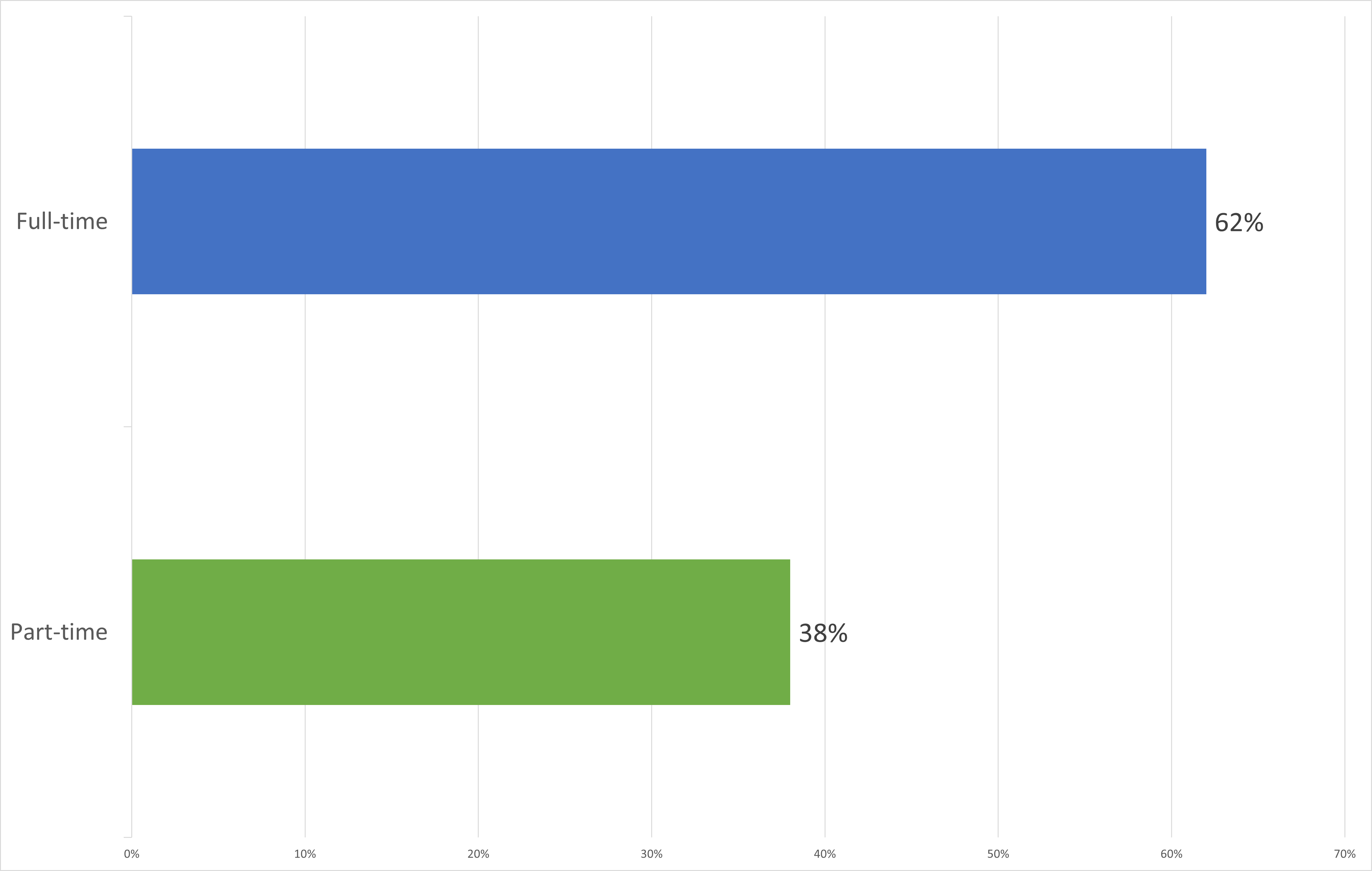
IPEDS Graduation and Transfer Rates
Another important factor in assessing achievement of goals and mission of the institution is reviewing and comparing the College in terms of its graduation rate and transfer rate.
Transfer rate is the percentage of a school's first-time, first-year undergraduate students who transfer to another college within 150% of the published time for the program. For example, a student who is in a four-year degree program is counted as a transfer if the student goes to another college within six years.
Graduation rate is the percentage of a school's first-time, first-year undergraduate students who complete their program within 150% of the published time for the program. For example, for a four-year degree program, entering students who complete within six years are counted as graduates.
Based on the most recently collected data, Lawson State has a current graduation rate of 23% and a transfer rate of 16%.
Graduation Rate and Transfer Rate Data (2015 - 2019)
| FALL COHORT |
2019 (as reported in 2023) |
2018 (as reported in 2022) |
2017 (as reported in 2021) |
2016 (as reported in 2020) |
2015 (as reported in 2019) |
|
Graduation Rate 150% |
23% | 25% | 21% | 19% | 17% |
| Transfer Out Rate | 16% | 15% | 25% | 24% | 27% |
The College monitors the rate of credentials awarded for its Associate of Arts, Associate of Science, Associate of Applied Science, and Associate of Occupational Technology degrees, as well as the number of Certificates earned.
| YEAR | ASSOCIATE DEGREES | CERTIFICATES | TOTAL | CHANGE FROM PREVIOUS YEAR |
| 2021 - 2022 |
314 |
262 | 576 | +1.5% |
| 2020 - 2021 | 337 | 248 | 585 | -26.8% |
| 2019 - 2020 | 431 | 368 | 799 | +13.5% |
It is difficult for community colleges to gauge success on graduation results exclusively; that is due in large part to the many roles that the College plays within its community and through its actions to serve its diverse population of students. For example, some students enter the College with the intent of taking transfer credits and transfer early without graduating. The College, then, views this as achieving part of this mission. Further, some students enroll in Lawson to acquire specific skill sets to enhance their abilities in the workforce, not necessarily to achieve a full certificate or degree. Lawson views its ability to address this student and his/her/their needs as equally important in fulfilling part of its mission. Thus, the College does not set a specific graduation benchmark for its feels a focus on retention and persistence will ultimately lead to increased graduation results.
Yet, the College does compare itself to other community colleges within the Alabama Community College System. In doing so, it helps to put the 23% graduation rate into perspective.
Data secured from IPEDS is based on a 150% graduation rate and is reported in the rears. Information for 2019 rates from other schools will not be available until late-2023. So, although 2019 data is available for Lawson (as shown in the above "Graduation Rate and Transfer Rate Data" table) 2018 numbers will be analyzed for this discussion.
To review, Jefferson State is the only other two-year college that serves the Birmingham area and is Lawson's lead competitor. Presently, their graduation rate is 21% versus Lawson's rate of 25%. Shelton State is the second closest school to Birmingham, and it holds at 27% graduate rate versus Lawson's 25%. However, other larger community colleges have better graduation rates to include Bevill at 37%, Gadsden at 27% and Calhoun (which is the largest community college in the state) at 32%.
Graduation Rate Comparison with Other Two-year Colleges
| INSTITUTION |
2018 (as reported in 2022) |
2017 (as reported in 2021) |
2016 (as reported in 2020) |
2015 (as reported in 2019) |
| BEVILL STATE COMMUNITY COLLEGE | 37% | 31% | 28% | 22% |
| GADSDEN STATE COMMUNITY COLLEGE | 27% | 27% | 25% | 21% |
| JEFFERSON STATE COMMUNITY COLLEGE | 21% | 16% | 15% | 10% |
| CALHOUN STATE COMMUNITY COLLEGE | 32% | 29% | 26% | 23% |
| SHELTON STATE COMMUNITY COLLEGE | 27% | 15% | 20% | 22% |
| LAWSON STATE COMMUNITY COLLEGE | 25% | 21% | 19% | 17% |
Presently, the College is not meeting its pre-set bench mark of 55% for a transfer rate. When reviewing most current data (as reported in 2023) Lawson State's transfer rate is at 16%.
When a benchmark has not be reached, the College uses other methods to assess the overall achievement level of an intended goal. In this case, Lawson State's transfer rate would be compared to similar two-year colleges in the Alabama Community College System. In looking at the comparison chart below, it shows Lawson's transfer rate from reported data in 2022 is lower than the median average transfer rate from other two-year colleges in the same community college system of 18.5%. It does show Lawson State has a higher transfer rate than Bevill State (at 14%) and Gadsden State (at 4%). Jefferson State as the highest transfer rate (at 35%), but it still doesn't meet Lawson's benchmark performance of a transfer rate of 55%. This could indicate the benchmark Lawson set for itself may need to be reevaluated during the College's Administrative Leadership Team summer retreat.
Transfer Rate Comparison with Other Two-year Colleges
| INSTITUTION |
2018 (as reported in 2022) |
2017 (as reported in 2021) |
2016 (as reported in 2020) |
2015 (as reported in 2019) |
| BEVILL STATE COMMUNITY COLLEGE | 14% | 16% | 14% | 16% |
| GADSDEN STATE COMMUNITY COLLEGE | 4% | 17% | 13% | 14% |
| JEFFERSON STATE COMMUNITY COLLEGE | 35% | 34% | 28% | 26% |
| CALHOUN STATE COMMUNITY COLLEGE | 20% | 20% | 22% | 23% |
| SHELTON STATE COMMUNITY COLLEGE | 23% | 7% | 25% | 26% |
| LAWSON STATE COMMUNITY COLLEGE | 15% | 25% | 24% | 27% |
The College has implemented several initiatives, including QEP: Race to the Finish, in an effort to highlight completion and transfer importance. In doing so, the College has conducted several work / professional development sessions examining how the College can address and improve retention. These initiatives focus largely on: 1.) Advancing student knowledge and understanding of the Alabama Transfers guide which outlines what courses (if taken at Lawson) will transfer to their select or intended four-year university; and 2.) Providing better guidance and advisement about the "15 to Finish" campaign that is designed to help students graduate and stay in school. Other initiatives are mentioned below. Collectively, these efforts work to improve graduation, retention and transfer rates.
Initiatives to Promote Graduation and Transfer Programs
- Embed Alabama Transfers information into all Freshmen Academy (ORI 101) classes
- Require all students to complete an Alabama Transfers degree map
- Add an Alabama Transfers informational page to the College's website
- Host college fairs on campus
- Work to expand college transfer scholarships
- Embed the "15 to Finish" program college-wide
- Embed the "15 to Finish" pledge into the Freshmen Academy (ORI 101).
- Focus on advising and retention as part of the College's QEP: Race to the Finish.
State Licensing (NCLEX Results)
As previously noted, Nursing is the largest program at the College and drives enrollment to a large degree. Thus, given its imprint on the College and the overall number of students enrolled, results from the Nursing Licensure exam are used as a measure of student achievement.
The College has two Health Professions Programs which require state licensing prior to becoming employed in field: the Associate Degree Nursing and Practical Nursing. Both the Associate and Practical Nursing Programs are approved by the Alabama Board of Nursing and are accredited by ACEN (Accreditation Commission for Education in Nursing). Candidates for licensure must pass the National Council Licensure Examination for Registered Nurses (NCLEX--RN) or the National Council Licensure Examination for Practical Nurses (NCLEX-PN), depending on their completed program of study.
The Alabama State Board of Nursing currently has a benchmark of 80% passage for the NCLEX. Both the Associate Degree Nursing Program and the Practical Nursing Program have exceeded this benchmark for the past three testing cycles. Furthermore, the Associate Degree Nursing Program is always listed Top 10 in the state and has been as high has #1 in the state several times. This ranking is in large part due to with the outstanding success this program has had with its pass rates on the NCLEX exam.
Lawson State, to ensure it maintains a high pass rate, requires all students take an NCLEX Bootcamp to prepare for the exam and does extensive program and curricula reviews to provide for engaged and hands-on learning opportunities for nursing students. The program also has invested heavily in producing a state-of-the-art simulation lab complete with interactive patient simulators.
Associate Degree Nursing Program: NCLEX Pass Rates
| YEAR |
NUMBER OF STUDENTS TESTED |
NUMBER OF STUDENTS PASSED | LAWSON'S NCLEX PASS RATE | STATE NCLEX PASS RATE BENCHMARK |
NATIONAL NCLEX MEAN PASS RATE |
| 2020 | 47 | 45 | 95.7% | 80% | 86.6% |
| 2021 | 39 | 35 | 89.7% | 80% | 82.8% |
| 2022 | 30 | 25 | 83.3% | 80% | 79.9% |
Practical Nursing Program: NCLEX Pass Rates
| YEAR |
NUMBER OF STUDENTS TESTED |
NUMBER OF STUDENTS PASSED | LAWSON'S NCLEX PASS RATE | STATE NCLEX PASS RATE BENCHMARK |
NATIONAL NCLEX MEAN PASS RATE |
| 2020 | 21 | 21 | 100% | 80% | 83.1% |
| 2021 | 18 | 17 | 94.4% | 80% | 79.6% |
| 2022 | 23 | 22 | 95.7% | 80% | 79.9% |
The next two charts show an NCLEX Pass Rate comparison of Lawson State to other, similiar two-year state community colleges.The other community colleges were chosen based on location to Lawson State and their size.
NCLEX - Associate Degree Nursing Pass Rate Comparison to Other Colleges
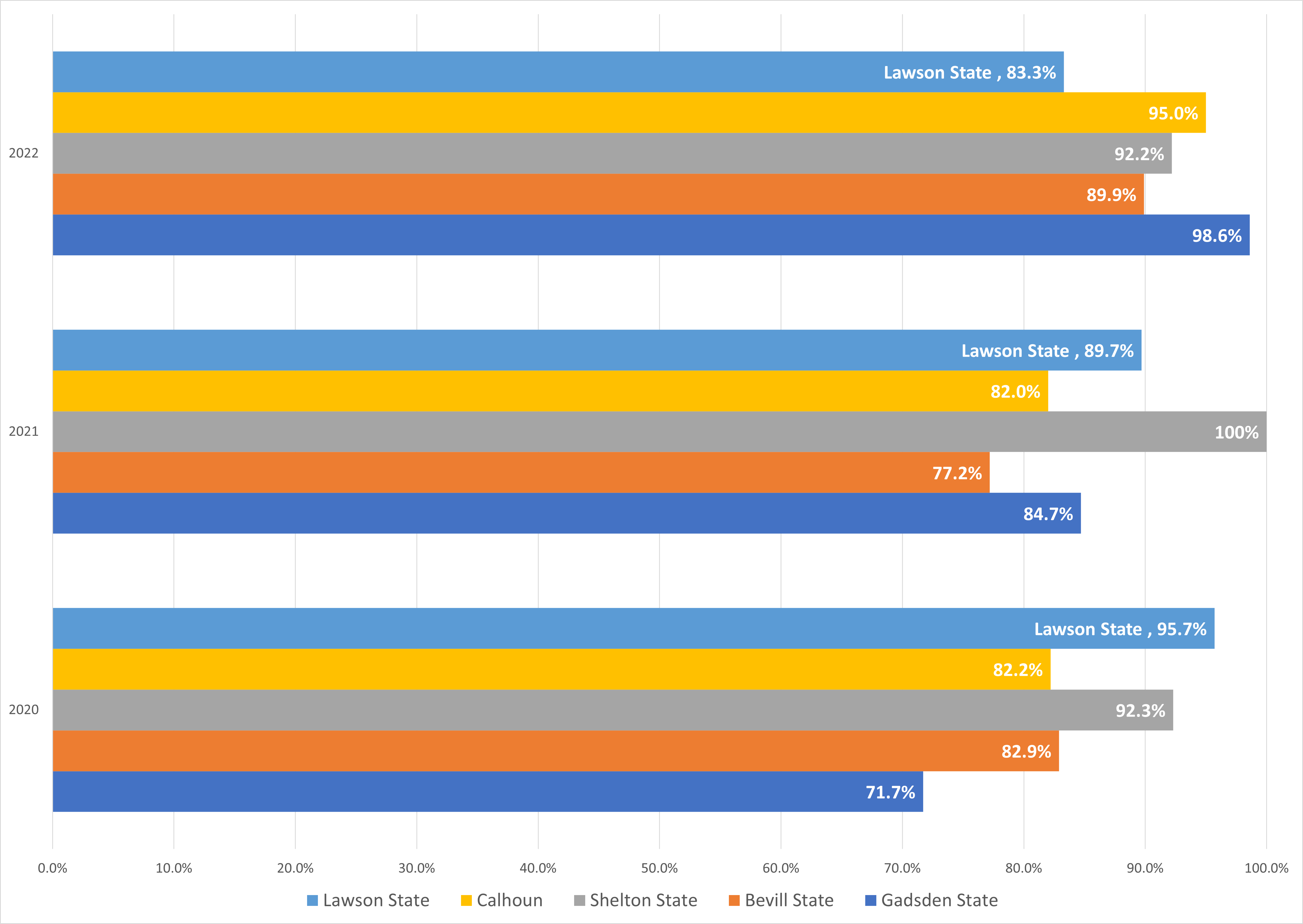
NCLEX - Practical Nursing Pass Rate Comparison to Other Colleges
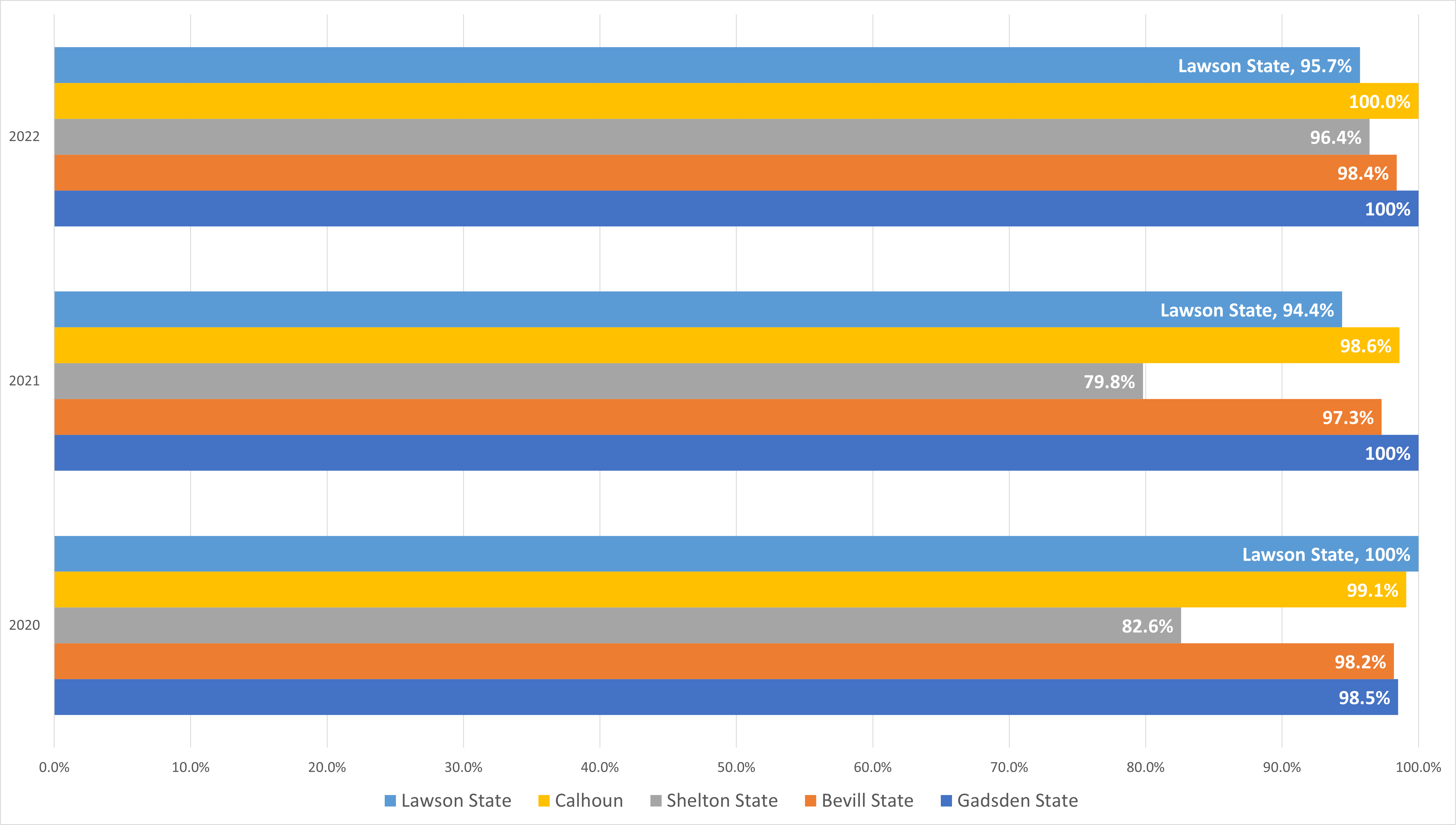
Job Placement
Job placement rate is another indicator of student success and achievement. The College's Associate Degree Nursing program and Practical Nursing program students have had a 100% job placement rate for the past three years.
The below table compares job placement rates for nursing program students from similiar, two-year community colleges.
RN and PN Job Placement Rate Comparison to Other Colleges
| INSTITUTION |
2022 |
2021 |
2020 |
| BEVILL STATE COMMUNITY COLLEGE | 84% | 81% | not listed |
| CALHOUN STATE COMMUNITY COLLEGE | 83% | 66% | 79% |
| SHELTON STATE COMMUNITY COLLEGE | 84% | 82% | 81% |
| LAWSON STATE COMMUNITY COLLEGE | 100% | 100% | 100% |
